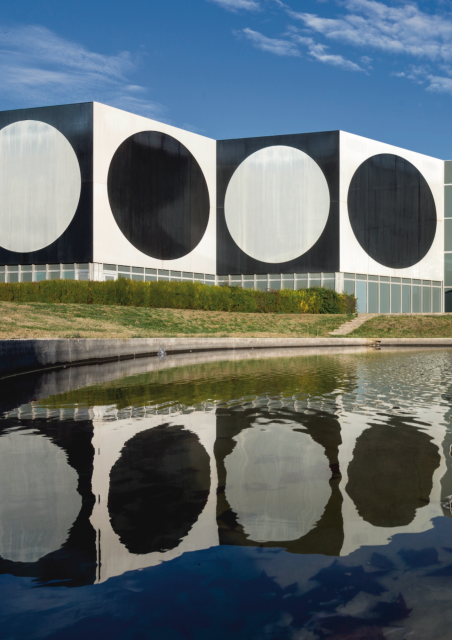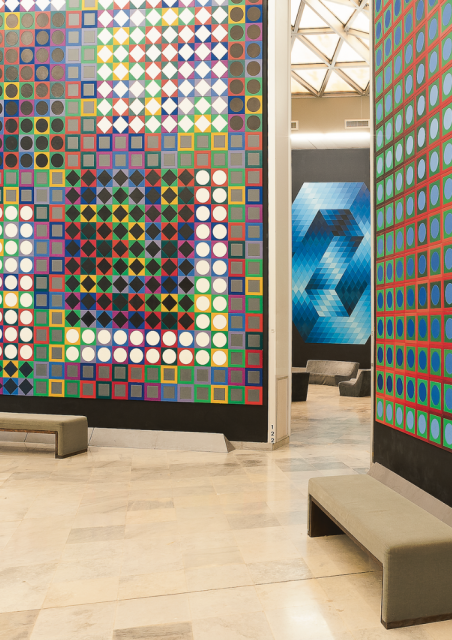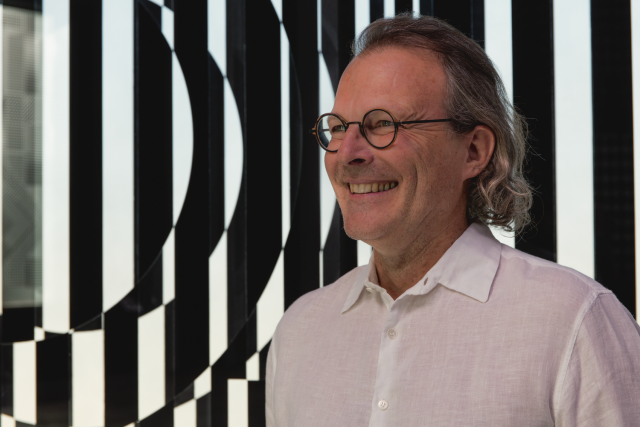Translated by Bethszabee Garner
The Vasarely Foundation, dedicated to the inventor of op art with its architectonic center located in the hills of Aix-en-Provence, has been the subject of much legal ink in the past. As the current president of the foundation and guardian of the artistic heritage, Pierre Vasarely, grandson and sole legatee of the visual artist, is organizing a series of exhibitions. We met in 2022 for the inauguration of the exhibition Cosmic Modernities.
Désirée de Lamarzelle: How do you view Victor Vasarely?
Pierre Vasarely: First of all, he was my grandfather, whom I knew very well until I was 37 and who was profoundly generous. He left behind him 60 years of work, with some fifteen different periods between 1930 and 1992, the last year of his career. He was a very accomplished artist, capable of producing very beautiful portraits, nudes and even landscapes, something that we don't necessarily know about him. He was gifted from a young age: at the age of four, he was already making a name for himself in the family home with his first drawings on the windows, animated by the mist he enjoyed blowing.
Désirée de Lamarzelle: He left Hungary to pursue his career in France?
P.V.: Yes, he left his native Hungary in 1930 after a decisive stint at the Hungarian Workshop founded by Sándor Bortnyik, which was in a way the study center of the Bauhaus in Budapest. It was from this period that he would show the extent of his talent, starting out as a graphic designer between 1930 and 1939, where his creations for advertising campaigns (Lesieur, Nicolas wines, Air France, SNCF, etc.) bore the seeds of what he would go on to do as an artist. He was to be praised by the work of an American published in 1940, Vasarely unknown, in which he recounts the existence in Paris of an extremely talented Hungarian artist. This contributed to his early fame.

Désiree de Lamarzelle: It's rare for an artist of this caliber to have a day job...
P.V.: For him, it would be a first job, which would enable him to make a living and pursue his research at the same time. This is a very important aspect of his career because he followed the precepts of Sandor Bortnyik, who advocated a certain economic independence for artists through gainful employment: “Work to be able to buy your canvases, your pigments, etc.” A fundamental life principle. He was an immense worker, with this acute awareness of the passage of time and the fear of not being able to keep up.
Désirée de Lamarzelle: The creation of his foundation during his lifetime is proof of this?
P.V.: Yes, you have to be a visionary artist with a generous streak, but also a bit of a megalomaniac to dare to go against everyone's advice and finance your project by making a donation, without waiting for a city or a country to dedicate a museum to you. I'm not revealing anything by pointing out that he was a communist. This largely explains his desire to pass on or give back what he had received. He sold his works all over the world to devote himself to his foundation and restore the Château de Gordes, as well as building all the buildings of the foundation, which is recognized as being of public utility. At the same time, he made a donation to Budapest in homage to his native country. He also inaugurated the Vasarely Center in New York in 1978. All this was motivated by the idea of making art accessible to as many people as possible.
Désirée de Lamarzelle: Is that the aim of a foundation recognized as being of public benefit?
P.V.: The idea was to build this foundation in the middle of everyone, in the middle of the city, so that it would be accessible to as many people as possible. And the foundation, even today, has this vocation of welcoming all audiences because you don't need to be initiated into art to understand Vasarely's work: it's the retina that speaks, it's the eye that makes the amalgam with colors, shapes. So everyone perceives it with their own sensibility. The foundation hosts a lot of cultural mediation: for the little ones, for school children, for families. And it also welcomes young people from more disadvantaged backgrounds with the Foundation Orange and l’École de la deuxième chance.
Désirée de Lamarzelle: Is the foundation dedicated to breaking down social barriers?
P.V.: Opening the doors of museums to them that they never cross is quite easy with this extremely accessible art. I have attended conferences where I have been thrilled by the relevance of their remarks. When they leave, they have a ticket to come back with their family. Which is what most of them do. A teaching method has been developed. So this center is a place for research and a meeting place with this notion of education.

Désirée de Lamarzelle: What does the definition of a public utility foundation, which you are celebrating its 50th anniversary, cover?
P.V.: It is a law that was promulgated by Malraux, Minister of Culture in the mid-1960s. The idea was to enable wealthy people to bequeath part of their personal fortune to an object of general interest. There are very few foundations of this category. The Vasarely Foundation is the first to be monographic, i.e. it concerns only one artist. It aims to perpetuate the artist's work. This means having a sufficiently large heritage to be able to support itself because, as a private organization, it must be able to operate without subsidies. Although we received funding for the restoration of the building (between 2013 and 2019), we are not authorized to receive state aid for the operation of the foundation, even though we do a lot in terms of education.
Désirée de Lamarzelle: Does a public-interest foundation have any major constraints?
P.V.: This is one of the problems that arise with foundations recognized as being of public interest. In particular, the difficulties that the foundation's administrators will encounter upon the death of my grandparents, namely that the State had not necessarily anticipated the foundation's succession. This is when a whole bunch of people will appear who will try to recover money or works.
Désirée de Lamarzelle: But hadn't the foundation already had financial problems during your grandparents' lifetime?
P.V.: That's the version of Charles Debbasch, who has since been convicted. There were indeed deficits, but he made up for them by selling his works. When we realized that my grandfather was suffering from health problems, the question arose as to who should take over the foundation. Even though my father and uncle are administrators by right, neither of them felt able to take up the torch. An agreement was signed with the University of Aix-Marseille because my grandfather preferred that everything remain in the public domain.
Désirée de Lamarzelle: You are the foundation's legatee?
P.V.: My grandfather made me his sole legatee, he made me the holder of the moral rights to his work in his will in 1993. But I had to fight against my father and my uncle and also, above all, against their wives at the time, to get this will validated. It's a question of upholding the law. This means that if someone makes a barbaric use of his work, I am able to forbid it. If someone wants to go against the work, I can take legal action to have the artist's position recognized.
Désirée de Lamarzelle: You are also president of the Vasarely Foundation.
P.V.: I became president in 2009 after many twists and turns. I owe a lot to the provisional administrator appointed by the court, who spent almost two years completely overhauling the foundation's finances. This made it possible to rebuild a team, carry out restoration work on the building and put in place a cultural policy.

Désirée de Lamarzelle: This summer 2022, the foundation is hosting an exhibition in partnership with the Centre Pompidou.
P.V.: This partnership was conceived with the exhibition curator, Michel Gauthier, which follows on from the major Vasarely retrospective that took place at the Centre Pompidou in 2019. It was a huge success, with 400,000 visitors in three months. This reinforced the collaborative project, which takes place every year. The first exhibition took place in 2019, the second in 2020, and this is the third, called Cosmic Modernities. It will host around twenty major works from the Pompidou Center, some of which have never been shown before, on the theme of the cosmos. There will be two works by Vasarely because he was one of the first to be influenced by the infinitely large and the planets.
Désirée de Lamarzelle: Considered the father of optical art, Vasarely is also very representative of a popular art that is still very popular.
P.V.: There have been periods when there has been less talk of this work, but it is true that it has remained very influential in architecture, urban planning and music. For example, David Bowie, on the occasion of his first trips to Paris, went to meet Vasarely in his studio. And we find him in fashion and even advertising with the design of the Renault logo and the RTL front on rue Bayard in Paris.
Désirée de Lamarzelle: What has become of this building since RTL moved its headquarters?
P.V.: Received from RTL, the façade was brought back to us because it is a work of great contemporaneity. It is inalienable, but we would like to take advantage of this interview to send out a message: we are indeed looking for a space in Paris, or elsewhere.
Désirée de Lamarzelle: With your grandfather Victor and your father Jean-Pierre, known as Yvaral, both artists, were you not tempted to paint or sculpt?
P.V.: No, I realized very early on, thanks to my father, that I was a bad artist. For the record, he had told me to “get lost” when I gave him a small drawing for his birthday, explaining that he and his father were trying to bring order to art and that I was just chaos.
Article written by Désirée de Lamarzelle, to be found in issue n°1 of OniriQ Magazine.







